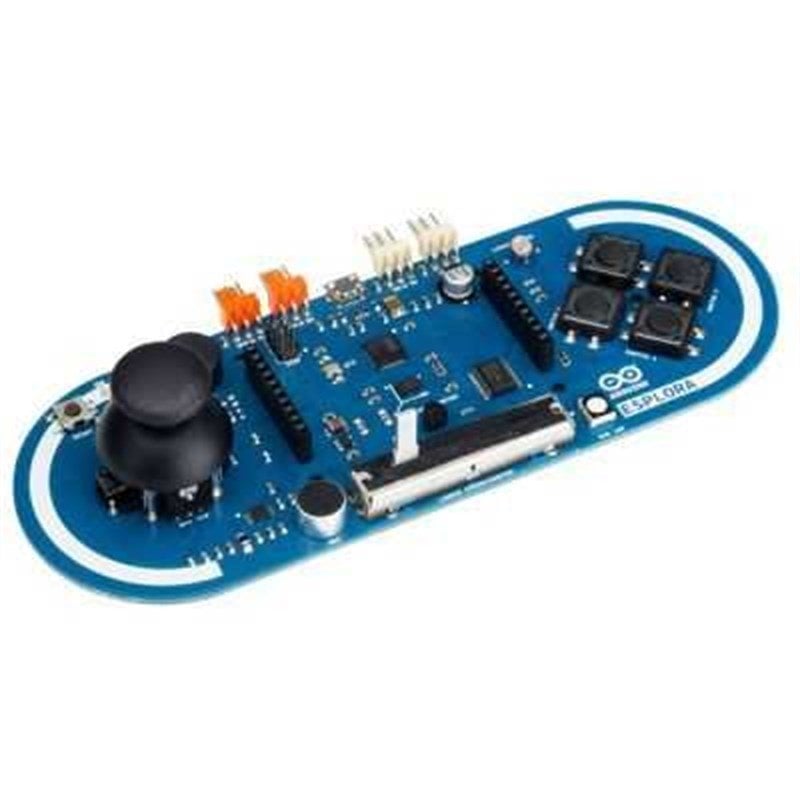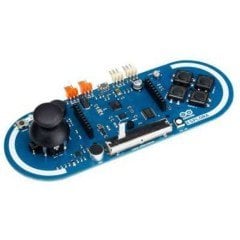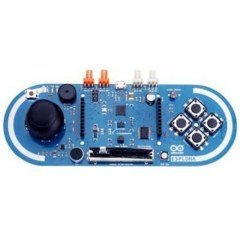Arduino Esplora (Clone)
The DM163 constant current LED driver provides peripheral PWM. This feature allows to apply 8 - bit PWM signal to each red, green and blue channel. Consequently, it is possible to generate 16 million diffrent color signal for each pixel.
There is an Atmega328 microcontroller on the board. So it is possible to program Colorduino using Arduino IDE. There is not any programmer chip on this board. To program the board, you may choose an external usb Serial converter.
Colorduino boards are able to connect themselves to build a bigger matrix. It is possible to connect these boards via 8-pin interafaces. The boards use I2C protocol to communicate.
Ther are two options to supply Colorduino. First, it is possible to supply the board via 8-pin interface using VDD and GND pins or the other option is to apply 6.5 - 7.5 V via VIN and GND connectors.

- 8-bit color definition for each pixe
- Peripheral 16 Mhz PWM frequency
- Usage without an additional circuit, except programmer
- Peripheral UART and I2C communication
- Constant 100 mA supply for each of 24 channels
Technical Features:
- Microcontoller: Atmega328
- Input voltage (8-pin interface): 5 V
- Input voltage (power connector): 6.4 V - 7.5 V (max.)
- Programming interface: UART/ISP
- Communication interface: UART/I2C
- Current (except LED matrix): 20 mA
- Current (for each channel): 500 mA
- Color resolution for each LED: 16 M
- Sizes: 60 mm x 60 mm
- Weight: 37 g
- DM163 (Datasheet)
- Colorduino (Datasheet)
- Board Schematic
- Fritzing Application
Applications:
This is a clone of the lasest version of original Arduino Esplora. There is a usb cable inside the package for seperator computer connection.
Product content:
- Arduino Esplora
- Micro Usb Cable
Arduino Esprola is a microcontroller board based on Atmega32u4, this board is builded on the Esplora board. The most important property of Esplora that the other Arduino boards do not have is having on-board sensors ready to use. This boards is designed for the people intent to do something with arduino but do not have knowlage on electronics. You may visit Getting Started with Esplora page to access step by step explaination.
There are a sound and a light out, a joystick, a slider, a temperature sensor, an accelerometer, a microphone and a light sensor input on the board. There are also 2 inputs and 2 outputs socket and a TFT LCD screen socket in order to add more sensors.
There are everything for the microcontroller to work on the board. The board can be easily connected to a computer via usb to start using.
Esplora board is seperated from other Arduino boards by using ATmega32u4 microcontroller, Atmega32u4 is able to communicate with a computer directly thus it does not need an USB - Serial converter. Thanks to these features, Esplora can be introduced to computer as not only virtual COM port but also as peripherals such as console and mouse too.
Features:
- Microcontroller: Atmega32u4
- Operating Voltage: 5V
- Flash Memory: 32 kB (Atmega32u4), 4kB is used by the bootloader
- SRAM: 2.5 kB (Atmega32u4)
- EEPROM: 1 kB (Atmega32u4)
- Clock speed: 16 Mhz

Memory:
Atmega32u4 has an 32 kB flash memory (4 kB of this is used by the bootloader), 2.5 kB SRAM and 1 kB EEPROM.
Input and Output:
Arduino Espora is designes as a standard game console with a joystick (on the left) and 4 buttons (on the right).
You may see the inputs and outputs on the board, below:
- Analog joystick with middle-button: 2-axis joystick (X an Y) and middle push button
- 4 push buttons: 4 push buttons placed as a square
- Linear Potentiometer: on the bottom of the board
- Microphone: To sense environmental sound
- Light sensor: To sense environmental light level
- Temperature sensor: To measure environmental temperature.
- 3-axis accelerometer: Measures the ratio to the gravity of the board on 3 axis (X, Y and Z).
- Buzzer: Sound out.
- RGB led: A led emitting 3 colors (Red, green and blue).
- 2 inputs: 2 inputs to add an external sensor etc. (Input Tinkerkit Connectors).
- 2 outputs: 2 outputs to provide an output signal. (Output Tinkerkit Connectors).
- TFT screen connector: A connector to add an external TFT screen, SD card or any other moduls operating with SPI protocol.
All these analog sensors are red by the analog multiplexer on the board.
Communication:
There are several options for Arduino Esplora to communicate with another arduino or microcontroller. Atmega32u4 provides UART TTL (5V) Serial communication via its 0 (RX) and 1 (TX) pins. 32u4 connects to a computer by opening a virtual serial COM port and allows the serial communication. Arduino IDE, thanks to its serial monitor find in the computer software, provides to send and recieve text based information. RX and TX leds on the board blink while the board is communicating via USB.
There is a phsycally serial port on the Esplora board but this number can be increased with the SoftwareSerial library as software.
Atmega32u4 provides I2C and SPI ports too. Wire library if to use I2C and SPI library is for SPI communication.
Thanks to these features, Esplora can be introduced to computer as not only virtual COM port but also as peripherals such as console and mouse too. You may visit Keyboard and Mouse classes page.
Programming:
Arduino Esplora board can be programmed with the Arduino computer software (Arduino IDE). You can start programming by choosing Arduino Esplora under tools > board menu on the Arduino IDE. For details you may see the referance and the basic functions page. Atmega32u4 on the Arduino Esplora board comes together with a specific software installed, named bootloader. Thanks to this it is not needed to use an external programming device to program Arduino Esplora. Communication is supplied by and original AVR109 protocol.
The board can be programmed by using ICSP headers via ISP programmer instead of bootloader software (Referance).
Esplore Library:
There is a library to read and write sensor values from the board for Esplora board.
The library provides half-raw values with high level methods. This means, it is very easy to read values from the sensors on the board. For example: To read the temperature you do not need to do extra operation, the temperature comes as Celcius. or you may easily write values to RGB leds.
For documents and example codes about the library. Esplora Library.
Usb high current protection:
Arduino Esplora board has restarable high current protectors. Even if your computer has its own protectors for its USB ports, the protectors on the board is adjusted to reject more than 500mA. If this amount of current is reached, protectors will keep open - circuit the connection untill the short - circuit disappears.
Note: The product content does not involve TFT LCD screen.
Documents:
- Atmega32u4 Datasheet
- Board schematics
- Eagle PCB files
- Esplora library
- Using Esplora as Mouse (Application)
- Arduino Software (Arduino IDE)
- Arduino Page




